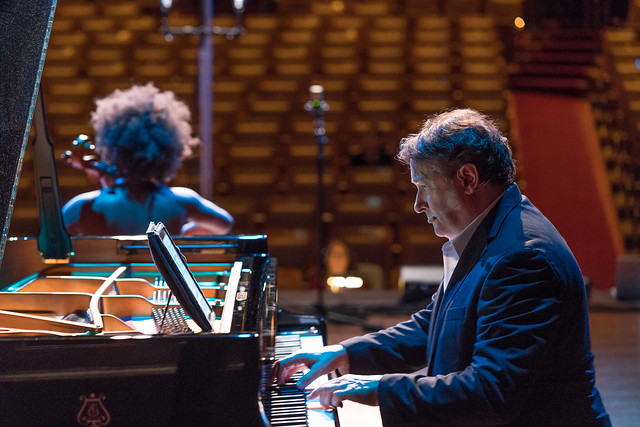 |
| Performing with one of my favorite page turners, Adam. |
In 2012, we watched Christopher O'Riley perform on From the Top with a laptop folded back on the piano. This was before tablets were widely used, and certainly before the full-size iPad Pro came out.
 |
| Christopher O'Riley with Gordon Neidinger, mandolin, From the Top 2012 |
 |
| From the Top Photo by Neale Eckstein, 2017 |
Cheapness does come with a price. I lost 0.8" on the diagonal screen dimension (12.2" vs 13"), but because of the aspect ratio, this becomes even more in the horizontal direction in portrait mode. The width of the page determines how large the sheet music appears on the screen. Full-size sheet music is 9"x12" which is the same 4:3 aspect ratio as the iPad, or 1.333. Even 8.5"x11" pages have a similar 1.29 ratio. By comparison, a 16:9 ratio is 1.778. Here's a little math to determine the difference in the width of the two screens.
So the width of my 16:9 12.2" tablet screen is 6" versus the iPad at 7.8". That's a huge difference in width! So how does 6" look against the same music on a 9x12" page?
Actually, not that bad since music apps crop the white space of the page. At first, I was bothered by the bluish hue of the white background but I finally found the sepia tone to be more like sheet music paper.
The first thing I realized about using digital sheet music is that you have to turn the pages twice as often as paper sheet music. Paper sheet music in books or binders always show two pages at a time. This is fine when the music is not very complex, but when you in a complicated passage near the page turn this can be quite stressful. If you stomp the pedal too many times or press both pedals at once, the on-screen keyboard may pop up by accident or worse the program crashes. This would be disastrous in a performance!
My initial app for sheet music was Orpheus, but then I moved to MobileSheets for this feature: half page turns! I watched a fellow chamber music pianists effortless play a piano trio with his iPad Pro and asked him how he became comfortable turning pages with the pedal. He showed me his nifty forScore app (iOS only at a pricey $14.99!!) and how he uses half-page turns. Wait - doesn't that mean you have to turn pages twice as often, or 4 times the number paper sheet music turns?
With half-page turns, you press the pedal somewhere in the bottom half of the page and half of the next page pops on top of the screen. Then you seamlessly play from the bottom of the screen to the top of the screen without having to worry about pressing the pedal at exactly the right time. After you get to the next page at the top of the screen, you press the pedal again when it's convenient to fill down the rest of the page. So page turns are essentially decoupled from the actual playing and don't have to be timed perfectly right. Even though it's more presses, it's far less stressful.
But I didn't have an iPad Pro with the forScore app! With some searching, I found that the free version of MobileSheets also had half-page turns. It's a little tricky to enable, so here are the instructions (note the sepia tone which is easier on the eyes):
Tap and hold the screen to get the bottom toolbar.
Under Display mode, select "Half Page". Also, you can set the Sepia tone lower on this settings page. Another setting I found invaluable was the page scaling mode (next button on the bottom toolbar). When you set to full screen, it stretches the page so that you don't get the letterbox wasted space you can see with the Orpheus screenshots at the beginning of this post.
Here is a half-page turn for a tricky passage in Beethoven's Archduke trio. You simply play from the bottom to the top of the page. In fact, this is a better way to learn the music through a paper page turn because you can see it all at once.
My first performance with digital sheet music was with Claude Bolling's Suite for Flute and Jazz Piano. My sheet music copy was purchased back in 1980 and is completely falling apart. Every time I practiced, more pages would opt to leave the binding and the scotch tape everywhere was getting ridiculous. The performance was definitely a bit more stressful with the digital page-turning, but it wasn't disastrous.
Still, I feel more comfortable with paper sheet music for performances. I mostly use digital sheet music to try out pieces before I decide to print them. Maybe someday I'll become more comfortable with it, but in the end, I'm still an old-fashioned paper sheet music gal. Thank goodness I didn't plunk down the money for the iPad Pro (although I'm sure I could find other uses for one)!










No comments :
Post a Comment